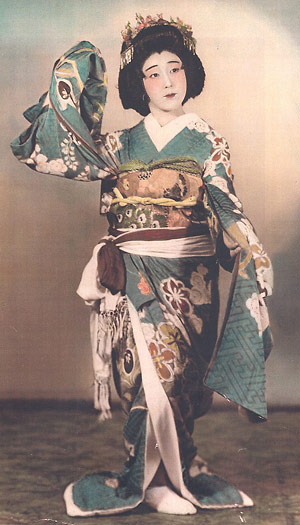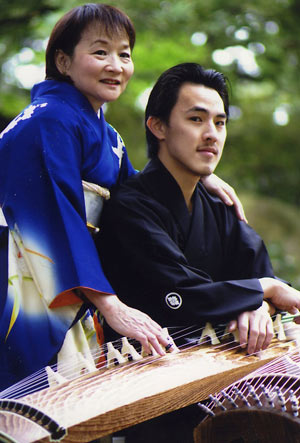How Japanese Americans preserved traditions behind barbed wire
For several decades, Berkeley staff member Shirley Muramoto Wong has tracked down elderly artists who, during World War II, taught traditional Japanese arts while imprisoned in far-flung "relocation" camps. In coaxing out and recording their memories, Muramoto — herself a master of the koto — has helped bring to light a little-known aspect of U.S. history.
June 10, 2010
At a century-old Buddhist temple in Los Angeles’ Little Tokyo, seven elderly Japanese American artists appeared recently in a once-in-a-lifetime performance of music, dance, and theater. The event, titled “Hidden Legacy,” honored individuals who taught traditional Japanese arts while imprisoned in far-flung WWII “relocation” camps.

Yukino Harada (né Okubo) performing a classical Japanese dance at the Amache internment camp in Colorado.
Mastery of any art or musical instrument requires patience, persistence, and time — as Shirley Muramoto Wong, who organized “Hidden Legacy,” should know. The Berkeley staff member and alum is a master of the koto, a traditional Japanese stringed instrument. Her discovery of internment-camp artists, too, required not years but decades — as she tracked down now-elderly artists, coaxing out and recording their memories, to reveal their unsung role in history.
Her interest was personal, as she had learned koto from her mother, who studied the instrument as a pre-teen at the Topaz, Utah and Tule Lake, Calif. camps. (While at Berkeley in the ’70s, Muramoto gave private lessons; she later taught her son Brian, who now teaches koto on campus with Professor of Music Bonnie Wade.)
Was her mother’s experience, learning koto behind barbed wire, unusual? Or had other internees connected with their Japanese heritage, at other camps, through the arts? And how had internees gotten sizeable kotos into camp, when they’d been forced to leave their homes with only what they could carry? “I love my koto, but it’s six feet long! It takes up a lot of space,” Muramoto remembers thinking.
The Public Affairs staffer scoured photo collections and pored over archival materials in L.A.’s Japanese National Museum, hoping that the “outpouring of research” since the U.S. government’s 1988 apology for the internment — offering monetary reparations along with self reproach for “race prejudice,” “war hysteria,” and “failure of political leadership” — would lead to answers.
A wealth of photos from the camps was by then available — though overwhelmingly of internees enjoying “all-American” activities such as baseball, swing dance, baton-twirling, and Scouting. That was no accident, Muramoto discovered.
“The War Relocation Authority, which oversaw the incarceration of Japanese Americans in concentration camps,” worked consciously on “Americanizing the Japanese Americans,” she explains. With war hysteria at a high after the attack on Pearl Harbor, and Japanese Americans’ loyalty in question, even the Japanese American Citizens League, a civil-rights organization, “was trying to encourage everyone to be more American.” Fearing FBI raids, persecution, even deportation, some destroyed musical scores and correspondence Japanese that might link them too closely with Japan.
Kabuki in the desert
Answers to her questions did not come easily, but word of her interest spread in the koto scene and the Japanese American community. A UCLA professor recommended a scholarly paper about a koto teacher at Manzanar, in the eastern Sierra. And she was excited to come upon a photo of a girl learning koto at Amache, in Colorado, as her mother had at Topaz and Tule Lake.

Shirley Muramoto and her son Brian with their kotos. (Alistair Wong photo)
“‘How much more of this is out there that we don’t know about?'” she remembers wondering.
Gradually Muramoto began to learn of individuals, many of them women, who had taught and organized performances of koto, biwa (lute), buyo (a dance form), nagauta shamisen (a string instrument accompanied by singing) or other traditional Japanese arts in major relocation camps throughout the American west and Midwest.
Biwa teacher Molly Kyokuto Kimura, in an interview, recalled how she decided to do “the unpopular thing” while imprisoned at the sprawling Tule Lake camp — start a Buddhist Sunday School and take instruction in Japanese language, flower arranging, tea ceremony, sand painting, and other Japanese arts.
Artist Bando Mitsusa, also at Tule Lake, earned $19 per month (the highest salary allowed) teaching buyo to 140 students. At Gila River, Ariz. and other camps, internees put on Kabuki theater performances, complete with scenery, painted on gunny sacks, and improvised costumes. At Amache, Matsui Suimin — a Kabuki producer by then arthritic and wheel-chair bound — fashioned theater wigs, using tin stovepipe as a base and strands of rope, dyed with black shoe polish, to look like hair. Artist Kotani Enjirou planted turnips at Tule Lake, for use in making papier-mâché masks for plays. Obon festivals, honoring the dead, took place in “just about every” relocation camp, Muramoto discovered.
As for those cumbersome kotos, many parents scavenged materials to build or repair instruments for their children, she learned. At Manzanar, internees used scrap wood, nails, and string to jury-rig practice kotos, and fashioned picks from cow bones and horn found on the grounds. Further north at Tule Lake, Muramoto’s grandfather, Yasuki Hori, turned a stripped-down koto body into a playable instrument for his young daughter — tying reeds together to make strings and carving tuning bridges from wood scraps and toothbrush handles. It “sounded terrible,” Muramoto speculates. “But they worked with their situation.”
Spreading word
Executive Order 9066: A musical response
In 1995, Kayoko Wakita unveiled a commissioned work, Executive Order 9066: The Japanese American Journey. At the “Hidden Legacy” event in L.A. this spring, Shirley Muramoto (koto) and her son Brian Mitsuhiro Wong (saxophone), performed ‘Conflict’ from that work — which pairs a classical Japanese koto piece with an American patriotic song.
Conflict (2:50 min.)
As a koto soloist and founding director of the Murasaki Ensemble, a jazz/world-music fusion group, Muramoto has performed for prime ministers, taught scores of private students, and overseen the release of six CDs (another, with her son Brian, is forthcoming). Lately, though, she has scaled back her performance and teaching schedule in order to focus on her research.
“All these artists are getting older, and I don’t know how much time I have,” she says.
With events in L.A. and San Francisco, showcasing internment-camp artists, now behind her, Muramoto’s next dream is to incorporate recordings from those performances, and her interviews with Japanese American artists, in a video documentary. In that way, she hopes to spread the word about a remarkable piece of history.
“All Americans are from somewhere; they have an ancestral culture,” Muramoto says, choosing her words with care. But as time goes on, traditions, if untended, fade. “It might not be such a bad thing to remember some of it again,” she suggests. “What makes America special is that we come from so many different places. If we can remember some of that, it will make us richer people.”
More on Shirley Muramoto Wong: Campus koto player fuses the traditional and the modern (2004 article)